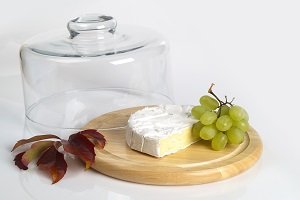Keeping cheese seems quite easy for most people: the cheese ends up in the fridge, where there is still room left. But do you want to store cheese properly so that it lasts long and does not lose its taste? Then read our tips on storing cheese and how to package different cheeses professionally.
1. Store cheese properly in several ways
For several thousand years, people have been making cheese. This goes hand in hand with the development of the correct storage of cheese. Since cheese is an initially perishable food, over time cheeses have been developed that are particularly storable. Improvements in industrial cheese production as well as modern packaging materials such as plastic containers have made it possible to store cheese in most cases without any problems.
In addition to aluminum foil, plastic packaging, cling film or a storage box made of plastic, cheese can also be stored in a can without environmental protection. These include, for example, alternatives such as a storage box or a cheese bell made of glass, ceramics or stainless steel.
2. The right packaging for every cheese

Always store soft cheese so that it can breathe.
Meanwhile, the offer for cheeses is as big as never. There are pre-packed cheeses from the refrigerated counter as well as fresh cheese and cheese slices from the cheese counter.
Depending on which cheese you like to eat, there are different storage locations available, so that the individual cheeses retain their full aroma:
- in the refrigerator
- in the basement
- in the flat
- on the balcony
If you want to store cheese without a fridge, you should at least have a cool room in the apartment. Alternatively, it is advisable to keep cheese in the basement or on the balcony. The latter, however, is more suitable for cold days or for the winter, as long as no sun shines on the balcony.
3. Store individual cheeses correctly
Good to know: In most apartments, the bedroom is the coolest room.
Below, read on how to properly preserve different types of cheeses, such as cheese slices, sliced cheese or soft cheese, for your recipes or for pure enjoyment.
3.1. This is the best way to store solid cheese
If you want to preserve a hard-sliced cheese or cold cuts such as Gouda, Emmentaler, Tilsiter or Appenzeller, you can do it as follows: either leave the cheese directly in the packaging in which you bought it and put it in the fridge along with the packaging ,
However, the cheese in the fridge is not placed somewhere but in the vegetable compartment. This is because the temperature in the vegetable compartment is constant. Otherwise, opening or closing the refrigerator door will cause temperature changes in the refrigerator. In the vegetable compartment, the cheese is additionally protected by the surrounding plastic shell.
Alternatively, you can take the cheese or cheese topping out of its packaging and wrap it in cling film before putting it in the fridge. Make sure that the cheese is not airtight but can breathe. Therefore, a container made of plastic, which seals the cheese airtight, rather unfavorable.
3.2. This is the best way to store cheese properly when it is soft
In order to keep soft cheese like Brie, Limburger, Romadur or Camembert, you should resort to special cheese cans. These cheese boxes are designed to have an extra valve. You can also regulate the air supply in order not to close the soft cheese airtight.
Nevertheless, the ventilation valve has the advantage that the food inside can breathe, but do not distribute their odors throughout the refrigerator . This is very convenient, since especially soft cheese, which also includes mold cheese such as Gorgonzola, is sometimes very odor-intensive.
Of course, you can also wrap the soft cheese in cling film. Make sure you have some air holes in the film. While you can even store solid cheese in the cellar, you should definitely refrain from soft cheese. Without a refrigerator, soft cheese will either completely melt or spoil quickly.
4. So store more cheeses properly
In addition to hard cheese or hard cheese and soft cheese, there are other cheeses such as cream cheese, processed cheese such as raclette cheese or grated cheese such as parmesan cheese. The best way to store these cheeses is as follows:
5. How to store cheese properly without plastic

Under a cheese bell all cheeses remain fresh and aromatic for a long time.
If you want to completely dispense with plastic and plastic packaging, the following alternatives are available: You can store especially hard cheese or any other sliced cheese and soft cheese well under a cheese bell.
Under a cheese jar made of glass or ceramic, the cheese not only remains fresh, but also unfolds its full natural flavor. Always put the cheese out of the refrigerator half an hour before consumption. In addition, you can make the cheese on the cheese plate, which is mostly made of wood, especially appetizing.
For example, you can wrap hard cheeses that have already been cut into baking paper and place them in the fridge. Otherwise, you can store suitable cheese breathable even without a refrigerator, if you cover it with a clean kitchen towel and put in a cool dark basement room.
6. FAQ about how to store cheese properly
Can you freeze cheese?
If you want to store cheese in the fridge, place it in the vegetable compartment. Soft and fresh cheese are unfortunately not good for freezing. Fixed cheeses in one piece can best be airtight frozen in the freezer bag or a corresponding storage box.
If you would like to freeze slice cheese, you should first separate all slices with baking paper to avoid sticking together when thawing. Always thaw frozen cheese in the refrigerator and not at room temperature.
How long can you store vacuumed cheese?
Many cheeses are unopened for about one to two weeks. This shelf life can be extended by vacuuming cheese. This increases the shelf life of soft cheeses by a week and of hard-cut cheese by almost two weeks.
However, you have to expect that the cheese changes its appearance and taste, because the airtight packaging damages the cheese cultures.




